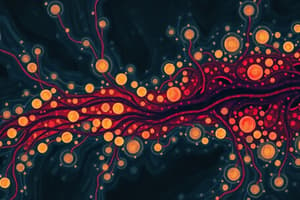Podcast
Questions and Answers
What is a concentration gradient?
What is a concentration gradient?
Difference in the concentration of a substance from one location to another.
What is passive transport?
What is passive transport?
Moving materials in or out of the cell without using energy.
What is active transport?
What is active transport?
Using energy to move materials in or out of the cell.
Which of the following are kinds of passive transport?
Which of the following are kinds of passive transport?
What is simple diffusion?
What is simple diffusion?
What occurs at equilibrium?
What occurs at equilibrium?
What is facilitated diffusion?
What is facilitated diffusion?
What is a channel protein?
What is a channel protein?
Which of the following are types of active transport?
Which of the following are types of active transport?
What is a carrier protein?
What is a carrier protein?
What are transport proteins?
What are transport proteins?
Which substances move easily through the phospholipid bilayer part of a cell membrane by simple diffusion?
Which substances move easily through the phospholipid bilayer part of a cell membrane by simple diffusion?
Which substances need a transport protein to move through the cell membrane?
Which substances need a transport protein to move through the cell membrane?
Flashcards are hidden until you start studying
Study Notes
Diffusion Concepts
- Concentration Gradient: Refers to the variation in concentration of a substance between two areas, influencing the movement of molecules.
- Passive Transport: Process where materials move across cell membranes without the expenditure of energy, relying on natural concentration differences.
- Active Transport: Requires energy to transport materials in or out of a cell against their concentration gradient.
Types of Transport
- Passive Transport Types: Includes diffusion, facilitated diffusion, and osmosis, which do not require energy input.
- Simple Diffusion: Involves molecules moving from a region of higher concentration to one of lower concentration, seeking balance.
- Facilitated Diffusion: Similar to simple diffusion, but utilizes transport proteins to assist molecules moving down their concentration gradient without energy usage.
Mechanisms of Transport
- Equilibrium: Achieved when the distribution of molecules becomes uniform across a space, indicating balanced concentrations.
- Channel Protein: A specific type of transport protein aiding in the passage of ions and water across the cell membrane.
- Carrier Protein: Facilitates the transport of specific molecules, such as glucose, through the membrane.
Active Transport Methods
- Active Transport Types: Comprises endocytosis, exocytosis, and protein pumps, all of which necessitate energy to move substances.
- Transport Proteins: Encompass both channel and carrier proteins, essential for the selective movement of substances across cell membranes.
Molecular Characteristics
- Non-Polar Molecules: Substances like carbon dioxide and oxygen easily permeate the phospholipid bilayer via simple diffusion due to their hydrophobic nature.
- Polar Molecules: Examples include glucose, water, and ions, which cannot pass freely through the membrane and require assistance from transport proteins to traverse cell membranes.
Studying That Suits You
Use AI to generate personalized quizzes and flashcards to suit your learning preferences.




